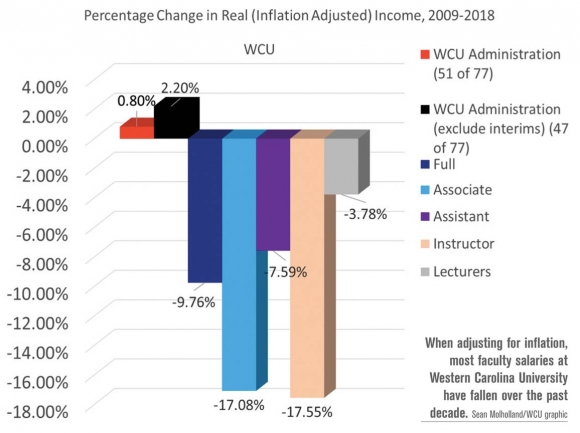Housing crunch exacerbates WCU’s stagnant salaries

With the state’s biennial budget process now nearing its conclusion, Western Carolina University employees are hopeful that they could soon see their first permanent raise in three years.
“It’s time,” said UNC System President Peter Hans in an interview during his July 1 visit to WCU. “It’s a matter of recruitment and retention and morale for incredibly hardworking individuals who saw the university through one of the greatest challenges I hope we ever see over the past year with COVID.”
Gov. Roy Cooper proposed a 7.5% raise over two years for university and community college employees, while the N.C. Senate more recently passed a budget that included a 3% raise. The House has yet to pass its version, but Hans anticipates that number will fall somewhere between Cooper’s proposal and the Senate’s. The three parties will then have to meet and settle on a final version.
“I’m going to stay after it,” he said. “I know the Chancellor (Kelli Brown) has been a strong and very vocal advocate, and I believe we’ll be successful.”
A decline in purchasing power
The salary issue is not new . It’s a perennial topic of discussion at trustees meetings and in budget negotiations, but a March 5 Board of Trustees presentation from Sean Mulholland, a WCU economics professor and associate director of the Center for the Study of Free Enterprise, shed new light on just how dire the situation is in Cullowhee.
Related Items
“By all accounts, productivity at Western is incredible,” said Mulholland, showing how the university’s 58.5% six-year graduation rate is the highest of 12 peer institutions listed for comparison. Earlier in that same meeting, trustees had recognized WCU’s Catherine Brewer Smith Distinguished Professor of Communication Sciences and Disorders Billy Ogletree for receiving the UNC system’s 2020 Governor James E. Holshouser Jr. Award for Excellence in Public Service, an honor that recognized Ogletree’s 28 years at WCU preparing people in the field or new to it to lead the way in supporting people with speech-language pathologies.
“The reason why we have good people like Professor Ogletree is because of investments in the past,” said Mulholland. “And that is why we are doing so well today.”
Over the 10-year period from 1993-2003, inflation-adjusted salaries at WCU rose by 8%, and while the size of the inflation-adjusted increase declined over subsequent 10-year periods, it remained positive up through the 2001-2010 period, when it just barely peeked over the 0% line. From there, the trend reversed, and ever since the 10-year change has been decisively negative, during the 2010-2019 and 2011-2020 periods reaching past negative 8%, according to Mulholland’s analysis.
Administrators are the only faculty members who have seen a positive change in inflation-adjusted income over the 2009-2018 period, at 2.2 percent when excluding interim appointments. Meanwhile, lecturers have seen a 3.78% decrease in inflation-adjusted income, assistant professors have seen a 8.59% decrease and full professors a 9.76% decrease, with inflation-adjusted income for associate professors and instructors plummeting by 17.08% and 17.55%, respectively. Those figures are significantly worse than the statistics for universities across the nation and in North Carolina.
“You do not see anywhere near the decline in real compensation that you witness at Western Carolina University,” Mulholland said. “That is, Western Carolina University is lagging relative to the higher education industry.”

A landscaped terrace in the Tom Apodaca Science Building offers a sweeping view of campus. Holly Kays photo
Meanwhile, 80% of staff who fall under the State Human Resources Act of North Carolina are paid below the median compensation for their job title, a $3 million recurring shortfall, Mulholland said.
At the same time, Western employees receive a lower employer retirement contribution and pay a higher healthcare premium than employees at peer universities nationwide.
‘Why isn’t N.C. investing in its future?’
Later in the March 5 meeting, Faculty Senate Chair Kadie Otto highlighted the urgency of the situation, issuing a plea on behalf of the Faculty Senate to bring back cost-of-living increases now.
“The fact that first-year college students were just five years old the last time faculty had a COLA is confounding. Why isn’t N.C. investing in its future?” reads the report she submitted to trustees.
A month and a half before the meeting, Otto emailed faculty asking them to share how the lack of COLA has affected them, and in response she received 113 emails spanning 55 single-spaced pages of text, she said. A thematic analysis completed by Assistant Professor of Marketing Heidi Dent revealed that 55% of responses expressed frustration, 19% expressed support, 18% concern, 7% fear and 1% hope.
“When I reflect on the time, energy, and effort faculty have put into surviving this crisis, what saddens me most is knowing what faculty otherwise would’ve been doing and thinking,” she wrote.
Housing at the core
Mulholland’s analysis dove deeper into that cost-of-living issue. Compared to peer university cities and UNC system cities, in a typical cost of living analysis Cullowhee comes out as middle-of-the road.
“Why is it that we feel as though it’s expensive to live here, but by the COLA metrics it’s not as expensive to live here?” he asked.
The answer, he said, is housing .
“The median house in Cullowhee is an apartment complex,” he said. “It’s not a single-family home.”
Apartments and mobile homes comprise three-quarters of the housing in Cullowhee. By comparison, in Chapel Hill, Raleigh, Pembroke, Wilmington, Durham, Greensboro, Asheville, Charlotte, Winston-Salem, Fayetteville and Elizabeth City — 11 of the UNC System’s 14 university cities — more than half the inventory is comprised of townhouses or single-family homes.
The median home in Cullowhee may well be less expensive than the median home in peer communities, but university professors don’t want to live in student apartment complexes. However, a three-bedroom house in Cullowhee runs about $300,000 — the fourth most expensive of the 14 UNC communities, said Mulholland.
Due to low inventory, even people willing to buy a $300,000 three-bedroom might not be able to find a house in Cullowhee. Only about 20% of Cullowhee’s houses have three or four bedrooms, with no five-bedroom houses available. That’s the smallest proportion of the 14 UNC university cities examined. In nine of those cities, more than half of the houses have three or more bedrooms.
“It takes a lot to set me off, but when I get set off I get set off, and this frankly doesn’t hurt me. It makes me angry,” said then-Chairman Bryant Kinney in reaction to Mulholland’s presentation.
Provost Richard Starnes said the university has been fighting to raise salaries for years, over the last seven or eight years investing $5.5 million in faculty and staff salaries from its own internal funding. But without help from the state, he said, it’s impossible to fully address the issue.
“We just can’t do it alone,” he said. “This is a situation where we’ll need support from the General Assembly to help rectify this.”
The need for salary increases is a discussion at institutions across the UNC system, but many of the issues in Cullowhee are unique to Cullowhee, as evidenced by Mulholland’s housing cost data.
Hans said he’s open to considering Cullowhee-specific solutions to this Cullowhee-specific problem, and that he and Brown are already discussing the pros and cons of various proposals.
“Actually, the chancellor (Brown) and I were meeting on a few creative approaches to this question earlier,” he said when asked about the possibility July 1, “although I’m not sure we’re prepared to unveil that at the moment.”









